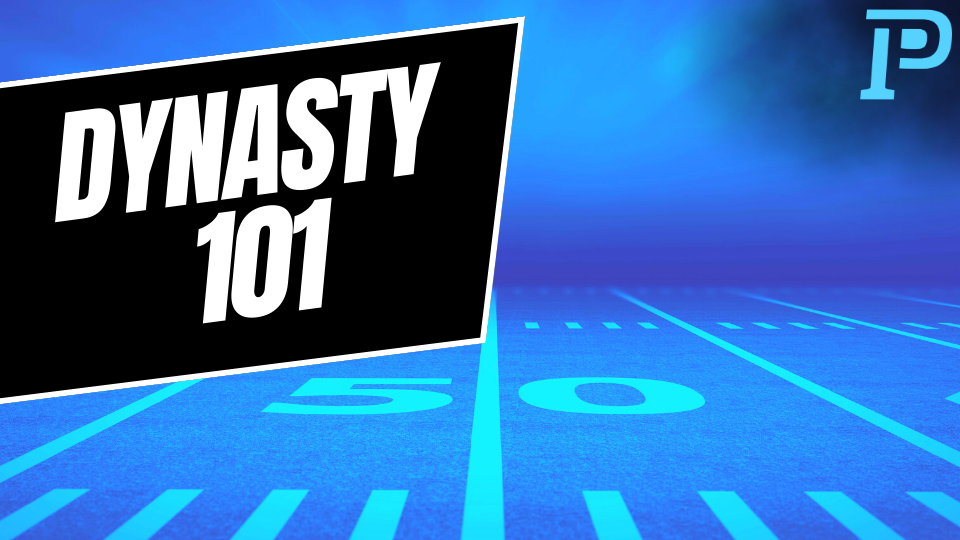When boiled down, fantasy football is a game with a series of different game modes. Redraft, Dynasty, Superflex, Guillotine, Best Ball….so many ways to play. If you are just starting out in fantasy football, you may be wondering what all these different game modes mean. Redraft is usually the starting point for someone new to fantasy, but if you are looking to take the next step to Dynasty, you are in the right place. Keep reading to find out more about the Dynasty League format of fantasy football!
The Basics
In the Dynasty football format, your leagues last for as many seasons as you and your league mates would like. Redraft leagues are season-long and must be renewed with a new drafting of players every year. However, in Dynasty, you draft in a “Startup” Draft once, then Rookie Drafts every year after.
The Startup Draft is for each manager to draft their team to start the league. This is the chance for you to choose if you want to start with young players to win long-term or stack up on veterans to try to win immediately. The players you choose in your Startup will be the core of your team. Then, rookie drafts will occur every year after the first year of the Dynasty League. In these drafts, fantasy gamers get the chance to choose from a pool of rookies from that year to add to their teams. So, you still get to draft every year, just from a smaller pool of players – all rookies you can evaluate to see whom you like and whom you don’t. This makes the NFL Draft season more intense and exciting!
League Features
A Dynasty League will be more dynamic than a seasonal league, meaning more constant movement and strategic planning all-round. You will have to carefully consider player age, contract length, injuries, and more to get a competitive team. The main feature of Dynasty that you cannot find in Redraft is offseason trading. After the Super Bowl, fantasy teams are allowed to deal players for Rookie Draft picks and/or other players. Managers can use the offseason to build their teams for the following season. You can analyze and peruse players all season long. Just be careful not to over-analyze and make a random June trade to fill a need that does not exist. For fantasy football managers who want to scratch the constant football itch in the offseason, this is the game mode for you.
An optional feature not found in seasonal leagues is a Taxi Squad. The purpose of a Taxi Squad is to stash promising young players until they can contribute. If you draft a rookie and place them on your Taxi Squad, you will not be able to play them for the season. However, you can “call them up” the following season and rotate new rookies into the Taxi Squad. Managers get to keep rookies that won’t contribute immediately and reap the benefits the following year. A rookie quarterback projected to sit for a year or late-round skill position players that will take a year to crack their team’s starting spots are prime candidates for the Taxi Squad.
Ultimately, be sure to check your league settings before drafting. Know the number of roster spots you have, how many players from each position would start, and whether or not you have Injured Reserve or Taxi Squad spots.
Dynasty Strategies
To win in a Dynasty league, several different strategies can be utilized. There are three main builds – Rebuild, Win-Now, and Neutral. Each build comes with a different prioritization of players for your roster. The Neutral build is the “default”, where you can just pick the best player on the board. This offers the opportunity to stack up on both youth and veteran players. You may eventually have to fully commit to a Rebuild or Win-Now direction, but Neutral is the easiest way to get started in Dynasty.
Win-Now mode means you should draft, trade for, or add players who will help you win in that immediate Dynasty season. This strategy entails targeting veteran players with established ceilings – so you know what you’re going to get, and they’re more short-term assets for your team. The Rebuild strategy entails drafting youth and stacking up on as many high Rookie Draft picks as possible. In this case, you shoot for upside and look to compete after a couple seasons, not immediately.
Lastly, keep in mind timelines for positions when you draft. For example, running backs have shorter lifespans, while tight ends rarely produce their rookie seasons. If you are in Win-Now mode, you would likely take a top rookie RB (Bijan Robinson) to produce immediately, but not a rookie TE (Dalton Kincaid). Keep in mind RBs typically are most viable in a 2–4-year span, while WRs often last longer and QBs have the longest career length in the NFL. This will help you decide what players fit your team’s timeline and assist you in constructing your roster accordingly.
That’s all for this primer on the Dynasty format for fantasy football. Now go try some Dynasty mocks and happy drafting!


